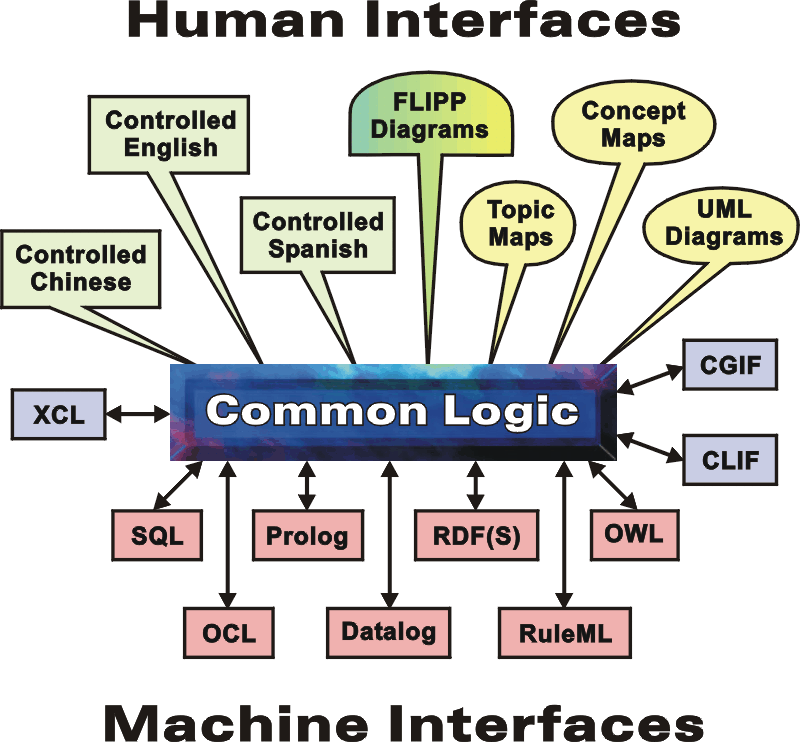Following is an edited version of a note I sent to some colleagues. Peter suggested that I send it to the group. (01) John Sowa (02) -------- Original Message -------- (03) Attached is a .gif file, which may be useful to clarify the relationships among various languages we have been discussing: (04) 1. At the top are the human interfaces: controlled natural languages in green and graphics in yellow. I have not mentioned any specific controlled NL, but there are many implementations, such as CLCE, ACE, and the Executable English that Adrian Walker has been discussing. In the middle are FLIPP diagrams (Format for Logical Information Planning and Presentation). FLIPP diagrams combine graphics with NLs, but the NLs could be replaced with controlled NLs. Therefore, the green and yellow are blended to indicate a combination. For an example of the FLIPP techniques, see (05) http://www.flipp-explainers.org/casestudy1.htm (06) 2. In the middle is Common Logic, which is the ISO standard. That is the hard interface to and from which all other languages are translated. Three dialects of Common Logic have been standardized by ISO, and they are shown in blue: CGIF (Conceptual Graph Interchange Format), CLIF (Common Logic Interchange Format), and XCL (an XML notation for Common Logic). (07) 3. At the bottom are logic-based languages used as machine interfaces. This is an open-ended list, but I included several as illustrations: SQL for relational databases, OCL for the UML Object Constraint Language, Prolog, Datalog, and the Semantic Web languages RDF(S), OWL, and RuleML. (08) At present, we have implemented the translators to support three languages and the mappings between them: Common Logic Controlled English (CLCE), CGIF, and Prolog. We intend to implement others as we get the time and funding to do so, but these three are the ones we are primarily using right now. We are also supporting the IKL extensions to Common Logic, which include metalanguage: (09) http://nrrc.mitre.org/NRRC/Docs_Data/ikris/IKLspec.pdf (010) > An interesting aspect of your diagram is what it tells us about > human cognition. What is it that makes the human interfaces > more readable by humans than the machine interfaces? (011) That is a good question, which involves many issues of linguistics, psychology, and human factors. We still do not have sufficient guidelines for determining what really makes languages and graphics readable and intelligible. (012) For some aspects, such as the type hierarchy, graphics have been used as a supplement to logic since the Tree of Porphyry in the 3rd century AD. But it's not clear how to increase the expressive power of the graphics without substantially reducing readability. One reason why I like the FLIPP diagrams is that they take advantage of the graphics for showing the logical structure and the NLs for their use of familiar vocabulary and syntax. (013) The UML approach of having a half-dozen different kinds of diagrams is also interesting. Each one expresses a different view of certain aspects of the logic and ontology. It would be interesting to explore systematic ways of highlighting, zooming, and focusing on various aspects. (014) > The human interfaces are "controlled" interfaces, capable of > being unambiguously mapped to strict logic. So they lack some > of the richness, ambiguity, and color of unrestricted natural > languages. But they are undeniably easier to read than the > machine interface languages. I imagine the reasons for this > difference have already been the subject of some serious study > in the literature, but I suspect that there is room for more. (015) Unfortunately, the people who address human factors and those who focus on the expressive power of the logic are almost completely disjoint. Furthermore, the journals, academic departments, and funding agencies are partitioned in ways that have the effect of keeping the skills disjoint. Professors who work on the boundary between two disciplines are often ignored by the promotion and tenure committees in both. (016) > I suspect that the distinction between human interfaces > and machine interfaces bears at least some relationship > to the distinction between good technical writing and bad > technical writing in natural language. (017) I agree. In fact, my hope for the combination of CLCE with graphics is to approach the style of a well-written, freshman level textbook in math or science. CLCE would express the precise definitions and axioms, the graphics tools would present the illustrations, and the comments would provide some of the background and motivation. (018) But there are many issues to be explored -- in human factors, computability, and logical expressivity. (019) _________________________________________________________________ Msg Archives: http://ontolog.cim3.net/forum/ontology-summit/ Subscribe/Config: http://ontolog.cim3.net/mailman/listinfo/ontology-summit/ Unsubscribe: mailto:ontology-summit-leave@xxxxxxxxxxxxxxxx Community Files: http://ontolog.cim3.net/file/work/OntologySummit2007/ Community Wiki: http://ontolog.cim3.net/cgi-bin/wiki.pl?OntologySummit2007 Community Portal: http://ontolog.cim3.net/ (01) |
